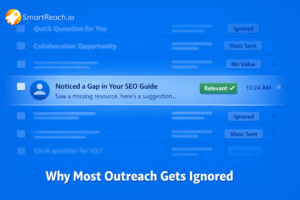Why Recipients Delete Emails & How It Hurts Deliverability
Email deletion rates are one of the most overlooked threats to email deliverability.
When recipients delete your emails without opening them, ESPs like Gmail and Yahoo see it as a clear sign of negative engagement.
This hurts your sender reputation and can slash your inbox placement by up to 40%.
For teams running cold outreach, it is important to keep the deletion rates low is now critical to protect ROI and stay competitive.
Deletion issues usually start small but quickly turn minor engagement drops into major deliverability crises across all your campaigns.
In this blog, we will check what are the various reason due to which email deletion rate could affect your deliverability.
What exactly is email deletion rate?
Email deletion rate is the percentage of people who delete your emails without opening them.
It includes:
- Immediate deletes (based on sender or email subject line)
- Preview deletes (after reading just the preview text)
- Bulk deletes (deleting multiple emails from your domain at once)
These actions tell ESPs like Gmail and Yahoo that your content isn’t wanted – making it a negative engagement signal.
When this happens often, it hurts your sender reputation and inbox placement rates (no. of emails that land in the primary inbox of the recipients)
ESPs track these patterns to decide if your emails should go to the inbox, promotions tab, or spam.
The more consistent the deletions, the worse the impact on your overall email deliverability.
Why does a high deletion rate hurt my email deliverability?
High deletion rates hurt email deliverability through several interconnected mechanisms that ESPs use to protect their users from unwanted content.
The key reasons are:
1. ESPs treat deletions as negative engagement
Email providers like Gmail, Outlook, and Yahoo monitor user behavior to decide whether your emails are welcome.
If recipients consistently delete your emails without opening them, ESPs take it as a clear sign:
- “This sender is irrelevant or unwanted.”
That’s active negative engagement, and it directly lowers your sender reputation the score ESPs use to determine inbox placement.
2. Deletion patterns damage your sender reputation
Deletion behavior is now a core factor in ESP algorithms.
This damage doesn’t happen overnight but consistent deletions across campaigns compound fast, quietly degrading your trust score over time.
3. It lowers your engagement score
ESPs reward senders with high open rates, clicks, and replies.
But high deletion rates, along with email bounces or spam complaints, drag your engagement score down.
It becomes a filter trigger pushing your emails into spam or the promotions tab, even if your content is solid.
4. Spam filters get smarter (and stricter)
Today’s spam filters aren’t just looking at words or links. They’re AI-powered and behavior-driven.
High deletions feed into machine learning models, signaling that your emails are being ignored or disliked pushing future campaigns closer to spam traps or blocking.
5. Deletion = symptom of deeper issues
A spike in deletion rate often points to:
- Poor targeting or email list segmentation
- Content mismatch with recipient expectations
- Over-emailing or frequency fatigue
In short, it’s not just a technical issue it’s a marketing misalignment.
6. One bad campaign can sink the next
Once your sender reputation drops, every future email suffers even the ones with great content.
You’ll start seeing:
- Lower open rates
- Less visibility in inboxes
- Cold leads and missed conversions
- Risk of domain blacklisting or domain damage
It’s a domino effect that can cost months of clean-up and significant revenue loss.
Why recipients delete emails without engaging
If recipients are regularly deleting your emails without opening them, it’s a sign something isn’t clicking.
There could be a no. of reasons for this, for example –
1. Irrelevant email content or poor targeting
- Email doesn’t match recipient’s needs or interests
- One-size-fits-all messaging instead of segmentation
2. Email fatigue & over-frequency
- Sending too often causes annoyance
- Leads to ignoring, deleting, or even unsubscribing
3. Weak subject lines & preview text
- Vague, confusing, or clickbaity subject lines
- Unclear preview text = instant delete
4. Dirty or outdated email lists
- Sending to disengaged or unverified contacts
- Purchased email lists = red flag for ESPs
💡Fix it: Clean your sending list & segment it (Tools like SmartReach.io can help with better segmentation)
5. Bad timing & inbox overload
- Emails sent during busy hours = bulk deleted
- Competing with dozens of other emails
6. Low trust or brand recognition
- Unknown sender name = immediate deletion
- Inconsistent branding hurts credibility
How can I make my emails more engaging to reduce deletions?
To cut down on deletions, focus on making your emails genuinely worth opening.
- Subject lines that deliver: Be clear and value-driven. Skip the clickbait, set the right expectations from the start.
- Content that hits home: Personalize based on segments, behavior, and preferences. Relevance is your best defense against the delete button.
- Timing that works: Test different send times to catch your audience when they’re most likely to engage, not bulk-delete.
Want to dive deeper into personalization, A/B testing, and content strategies? Check out our full guide on making your emails more engaging.
Conclusion: Making deletion rates a priority in your email strategy
Email deletions aren’t just harmless skips they send strong negative signals to ESPs, hurt your sender reputation, and derail deliverability.
With Gmail and Yahoo’s new engagement-driven filters, reducing deletion rates isn’t optional anymore, it’s a must.
The fix?
✅ Send relevant, personalized content
✅ Clean up disengaged contacts
✅ Monitor deletion behavior regularly
SmartReach.io helps you stay ahead with personalized sequences and real-time engagement tracking , everything you need to keep deletion rates low and inbox placement high.
Start your free 14-day trial and take control of your email performance today.
FAQs: Email deletion rate affecting email deliverability
1. What is a good email deletion rate?
A good email deletion rate is below 10%. Rates higher than 15% may signal low relevance and negatively impact your deliverability.
2. How does email deletion rate affect sender reputation?
A high email deletion rate signals negative engagement to ISPs, which can lower your sender reputation and reduce inbox placement.
3. Do ISPs like Gmail and Yahoo track email deletions?
Yes. Major ISPs track deletion behavior to assess engagement quality. Frequent deletions without opens are treated as a negative signal.
4. Can high email deletion rates cause my emails to land in spam?
Yes. Consistently high deletion rates can trigger spam filters, causing emails to be routed to promotions or spam folders.
5. How can I reduce my email deletion rate?
You can reduce deletion rates by segmenting your list, personalizing content, improving subject lines, and cleaning inactive contacts regularly.
6. Is deletion rate more important than open rate in 2024?
In 2024, deletion rate has become just as important as open rate. ISPs now prioritize overall engagement quality, including negative signals like deletions.
7. What tools can I use to track email deletion behavior?
You can track deletion patterns using tools like Google Postmaster Tools, Microsoft SNDS, and email platforms like SmartReach.io.
8. How long does it take to recover from high deletion rates?
Sender reputation recovery typically takes 4–8 weeks of consistent list cleaning, re-engagement, and high-quality content delivery.
9. Why do recipients delete emails without opening them?
Common reasons include irrelevant content, weak subject lines, poor targeting, inbox overload, and lack of trust in the sender.
10. What are the signs that deletion rate is hurting my email campaigns?
Signs include declining open rates, reduced inbox placement, higher bounce or spam complaint rates, and overall drop in campaign performance.
11. Do AI-based spam filters factor in deletion rate?
Yes. AI-driven spam filters use deletion behavior to detect unwanted content, which influences inbox placement and filtering decisions.




